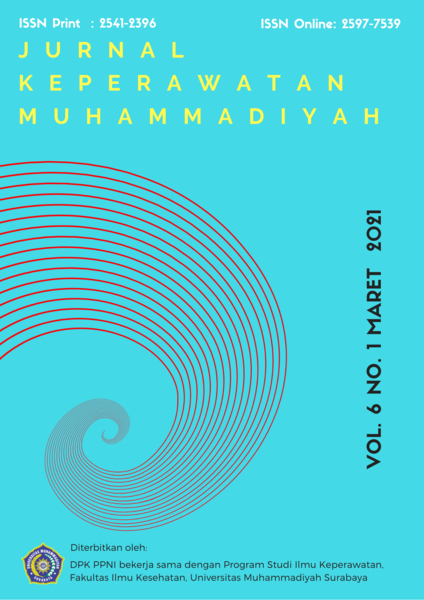Efektivitas Peran Bidan Sebagai Penentu Keberhasilan Bounding Attachment Antara Ibu dan Bayi Pada Masa Nifas
DOI:
https://doi.org/10.30651/jkm.v6i1.6323Keywords:
Peran Bidan, Bounding AttachmentAbstract
The bond between parents and newborns is very important to note. Since the antenatal period, mothers have to get information about bounding attachments, because since the antenatal period, the relationship between mother and child based on bonds of affection must be established. The success of the Bounding Attachment is largely determined by the midwife as a birth attendant. Through the first contact between mother and baby, namely early breastfeeding initiation (IMD), joining care and continued with exclusive breastfeeding. midwives are fully responsible for its implementation, provided that the baby and mother are in good health. Because this is the most important stage to initiate affection between mother and baby. The type of research used is Analytical Survey with a Cross Sectional Study approach. The sampling technique in this study was taken by using non-random (non-probability) sampling, by purposive method. The results of the research conducted at the Batua health center showed that midwives had a very important role in supporting the success of Bounding Attachments between mothers and babies during the postpartum period. Of the 65 respondents, there were 48 mothers who got the role of a good midwife. However, only 34 (52.3%) did the Bounding Attachment and 14 (21.5%) did not. 17 respondents did not get the role of a midwife, where 5 (7.7%) respondents did the Bounding Attachment and 12 (18.5%) did not. From the results of the analysis with the Chi Square test statistical test obtained Ï = 0.003 where Ï <α = 0.05, then Ho is rejected and Ha is accepted. It can be concluded that there is a relationship between the role of the midwife and the Bounding Attachment between mother and baby during the postpartum period.
References
Rukiah, Ai Yeyeh, Yulianti lia. 2012. Asuhan Neonatus Bayi dan Anak Balita. Jakarta: TIM
Arwani, Puspita. 2014. Faktor-Faktor yang Berhubungan dengan Pelaksanaan Bounding Attachment Pada Bayi Baru Lahir di RSU Semarang. Diakses, 13 Januari 2016.
Sugiono.2014._______________Metode Penelitian Pendidikan. Bandung: IKAPI
Bobak, Dkk. 2005. Buku Ajar Keperawatan Maternitas. Ed.4.Jakarta: ECG_____
Cahyaningrum, Mahardika. 2013. Tingkat Pengetahuan Ibu Nifas Tentang Bounding Attachment. Diakses, 7 Januari 2016
Anik, Maryunani. 2012. Inisiasi Menyusu Dini, Asi Eksklusif dan Manajemen Laktasi. Cet. 1. Jakarta : TIM
Utami, Rusli. 2008. Inisiasi Menyusu Dini Plus Asi Eksklusif. Jakarta: Pustaka Bunda
Wulandari, Setyo retno, Handayani Sri. 2011. Asuhan Kebidanan Ibu Masa Nifas. Cet.1. Yogyakarta: Gosyeng Publishing.
Dewi, Vivian Nanny Lia, Sunarsih Tri. 2010. Asuhan Neonatus Bayi dan Anak Balita. Cet. 3. Jakarta: Salemba Medika.
Kurnia, Mutiara. 2013. Hubungan paritas, Pengetahuan dan Pendidikan dengan Bounding Attachment pada Ibu Nifas dan Anak Bereunem Kabupaten Pidie Tahun 2013. di akses 8 Januari 2016.
Anonym, 2011.__________Diakses, 7 Januari 2016
Munirah.2014. Faktor-Faktor yang Berhubungan Dengan Pelaksanaan Bounding Attachment pada Bayi Baru Lahir di Puskesmas Terpadu Kalimantan Timur. Di Akses, 13 Januari 2016
Ansik khoiriyah(2014), ravita prihatini hubungan antara paritas dengan keterampilan menyusui yang benar pada ibu nifas https://doi.org/10.30736/midpro.v6i2.43 Vol 6, No 2 (2014)
Downloads
Published
Issue
Section
License
- Penulis tetap memegang hak atas karyanya dan memberikan hak publikasi pertama kepada jurnal ini yang secara simultan karya tersebut dilisensikan di bawah:Â Creative Commons Attribution-ShareAlike 4.0 International (CC BY-SA 4.0)













